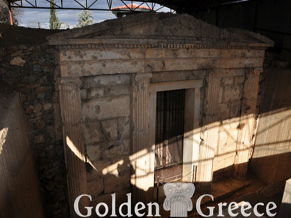
Simultaneously with the revelation of the royal tombs of the Aeges, in 1977, the conservation of the elaborate wall paintings that decorated them began immediately. At the same time, a maintenance laboratory was created on site for the rescue and restoration of the extremely important mobile finds they contained, as some of them were particularly sensitive (objects made of wood, ivory, cloth).
In order to protect the royal tombs, an underground building was constructed in 1993 that encloses and protects the ancient monuments, maintaining constant temperature and humidity conditions, which is necessary to save the frescoes.
From the outside, this building has the form of an earthen mound, while inside, since November 1997, the treasures found in the royal tombs have been exhibited.
The awe in the face of death, the glamor of the royal splendor, the emotion that gives rise to the tragic end of the royal house of the Temenids, are ideas inherent in the area of the royal tombs of the Aeges. These ideas determined the scenario of the exhibition, while the basic aesthetic choices were based on the notion that in a neutral and dark space, brightly lit and warm, only ancient objects should dominate.
The visitor who descends into the underground area of the tombs begins his tour with the representation of the Great Tomb, the monument that marked the location of the royal tombs and which no longer exists.
Tombstones and findings from the tombs of ordinary Macedonians, who after their death became neighbors of the king, provide a measure of comparison with the majestic Macedonian royal tombs and especially with that of Philip II.
A ruined tomb of the 3rd century BC, the fallen hero, which was a place of funerary worship for the kings who were buried under the Great Tomb, the charm and sadness of the fresco of the rapture of Persephone prepares the visitor to approach the dead King Philip II.
The pile of remains of the funeral pyre found all together thrown on the grave reminds of the tragic holocaust and at the same time hints at the passage to another dimension.
The tomb of Philip II, an archaeological discovery whose announcement made the rounds of the world!.. The brilliant weapons give a sense of the power of the ruler.
Next is the golden urn that contained the bones of the desecrated King Philip II and the oak wreath worn by the deceased. The golden urn, which weighed 11 kilograms, is decorated on its lid with the Macedonian star and on its sides with floral jewels and epithet rosettes of blue vitreous.
The golden oak wreath is the most valuable wreath that survived from Greek antiquity. It consists of 313 oak leaves and 68 acorns. It weighs 714 grams.
In the same area is the golden urn with the bones of the royal wife and the gold-embroidered cloth that wrapped them, as well as the two golden-ivory beds, timeless witnesses of the brilliant royal banquets.
The beds, which were luxurious utilitarian objects, had wooden frames and were richly decorated with ivory, glass and gold. Made by the hand of great ancient artists, they are two unique masterpieces of Greek micro-craftsmanship.
In the last section of the exhibition you will admire the finds from tomb III (tomb of the Prince), which probably belongs to Alexander IV, the son of Alexander the Great and Roxane, who was murdered by Cassander in 310 BC.
In the center is the silver urn with the bones of the young deceased, framed by the masterful ivory reliefs of the bed.
The exhibition is dedicated to the memory of Professor Manolis Andronikos, the archaeologist who brought to light the treasures of Vergina and had the knowledge and intellectual alertness to recognize them.
At the end of the route, in a space specially designed for this purpose, you will have the opportunity to hear the voice of the excavator himself as he guides you through the monuments.
Editor: Fotini Anastasopoulou